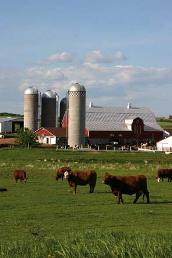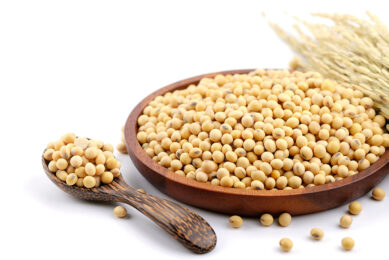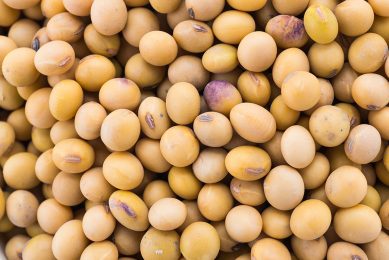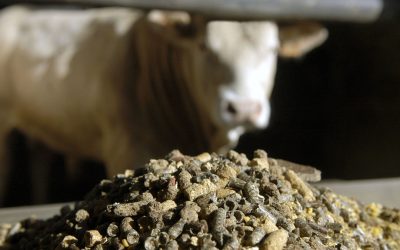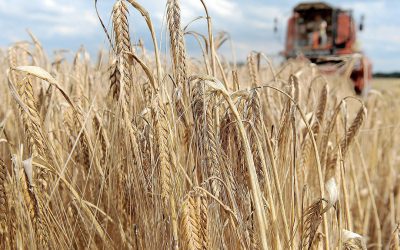Small farms (those with annual sales less than $250,000) represent a large majority of US farms (92%), but account for a relatively small share of total farm production (23%). The report from the Economic Research Service (ERS) of the US Department of Agriculture examines the other end of the size spectrum, where a large percentage of farm production occurs, specifically on “million-dollar farms” whose annual sales total $1 million or more. The 35,100 million-dollar farms reported in 2006—2% of all US farms—accounted for 48% of the sales of US agricultural products.
A variety of farm enterprises can generate $1 million in sales if they operate on a large enough scale (Figure 1). Estimates of the amount of crops and livestock necessary to generate $1 million of sales in 2005 are based on yields, livestock weights, milk production, and prices—generally reported at the State level—from Agricultural Statistics 2007.
Iowa corn and soybean farm, with a feedlot. Most of this farm’s sales came
from corn and soybeans, but it also supports a feedlot. The corn and soybeans exclude any crops grown to feed the cattle. Corn (450 ha) $ 375,894 + Soybeans (325 ha) $237,720 + Fed cattle (400 head) $ 448,656 = Total sales $1,062,270 Mississippi cotton and soybean farm. Upland cotton (and cotton seed) accounted for more than 80% of the sales of this farm. However, the farm also harvested 960 acres planted to soybeans. Cotton (840 ha) $823,678 + Cotton seed (1,150 tonnes) $106,276 + Soybeans (390 ha) $ 198,326 = Total sales $1,128,280 Arkansas broiler farm. To generate just over $1 million in sales, this farm produced 475,000 broilers under production contracts. The broilers are actually owned by the contractor, who also provides specific inputs, such as feed. The farm operator receives a fee for his or her services provided. Thus, the gross revenue of the farm—largely the fees received—is much lower than the $1 million in sales, which includes the value of the birds removed by the contractor.
North Carolina hog farm. Very large hog farms are a relatively recent development in North Carolina. Their introduction was facilitated by the use of contracts. To generate $1 million in sales, the farm —a finish-only operation—produces 8,000 hogs weighing 116 kg, the State average. No other farm enterprises are included in this example, since hogs account for 92% of sales of North Carolina hog farms, according to the 2002 Census of Agriculture. Wisconsin dairy farm. A Wisconsin dairy farm milking 400 cows would generate slightly more than $1 million, calculated from average production and price estimates for the State. This example assumes no other farm products are sold, although feed for the cows could also be grown.
California specialty crops. California’s specialization in high-value specialty crops dates back to the late 1800s. These examples show that even small area of specialty crops can generate sales of $1 million. Hectares needed for sales of $1 million: Head lettuce – 69, fresh tomatoes 50, celery – 48, strawberries 14.
Shifts in distribution
Major shifts occurred in the distribution of gross farm sales between the 1982 and 2002 Censuses of Agriculture, with sales measured in constant 2002 dollars. Farms with sales of $1 million or more doubled their share of total US farm sales from 23% in 1982 to 48% in 2002. Some of these million-dollar farms are relatively recent entrants to farming, while others existed as far back as 1978. The shift in production to million-dollar farms is likely to continue. Average operating profit margins increase with sales, reflecting economies of size in farming. As a result, million-dollar farms—and farms growing to that size—have a competitive advantage relative to smaller farms. The shift in production may eventually slow, however, once million-dollar farms’ shares of the commodities most amenable to large-scale production reach their upper limits.
No market power
Million-dollar farms do not have market power. The shift in farm production to million-dollar farms reflects a long-term concentration of farm production on fewer that has been underway since the beginning of the 20th century. However, there are still too many million-dollar farms—just over 35,000—for any single farm to dominate agriculture or the production of specific commodities.
Million-dollar farms receive a small share of Government payments. Most Government payments are commodity-related or targeted at current or past production of specific commodities, largely feed and food grains, cotton, and oilseeds. Relatively few million-dollar farms—particularly those with sales of $5 million or more—specialize in crops covered by commodity programs. As a result, million-dollar farms received only 16% of US Government payments in 2006, a small share compared with their 48% share of gross sales, although disproportionately large compared with their 2% share of all farms.
Family farms
Million-dollar farms have more operators than farms with lower sales. The number of operators per farm averaged 1.5 for all farms in 2006, but 2.1 for all million- dollar farms and 2.6 for $5-million farms. Multiple- operator farms accounted for 66% of million-dollar farms, substantially more than the 46% share for farms in general. Multiple-generation farms—those with at least 20 years’ difference between the ages of the oldest and youngest operators—made up a larger share of million-dollar farms (23%) than any other sales class. Most million-dollar farms are family operations. 84% of the million-dollar farms in 2006 operated as family farms—defined as any farm where the majority of the business is owned by the operator (or the principal operator on multiple-operator farms) and individuals related to the operator.
Only 7% of million-dollar farms were organized as non-family corporations, generally with no more than 10 stockholders. The situation was similar for farms with sales of $5 million or more, although a smaller share (64%) was classified as family operations and a larger share (21%) as non-family corporations.
The operators and spouses on million-dollar farms, however, provided only 10% of the farms’ labour, compared with 39% for farms with sales between $500,000 and $999,999.
Million-dollar farms account for most contract production – 39% of US farm production came from farms with production or marketing contracts in 2006, and million-dollar farms accounted for about 62% of this contract production. 63% of million-dollar farms used contracts, and about half of their production—mostly livestock—was under contract.
Source: Feed Tech 13. 2
